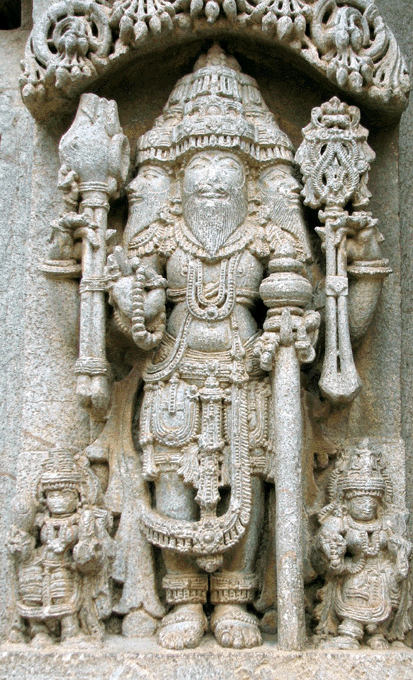
|
|
|
|
It's important to remember, however, that the intention when these great temples were built was to fill them with an array of images of the Supreme Personality and His transcendental associates, who are themselves worshipable insofar as they are great devotees of the Lord, so that the devotees could have their darshan and get their blessings. So regardless of the fact that Lord Brahma, or Visnu, or Shiva, or Nrsimhadeva, might appear as a bas-relief wall sculpture in some remote corner of a huge temple complex filled with other such images, we should keep in mind that these are deity forms, not simply decoration. While there may not be daily puja for these divine personalities today, consider the vast number of devotees who have passed through these holy shrines over the hundreds and thousands of years they've stood, and who have worshipped the various deity forms with great love and devotion. This point deserves further emphasis in the context of our series on "places of worship of Lord Brahma", because we have obviously not restricted our coverage to temples where there is a deity form of Brahmadeva on an alter, receiving daily puja. The category of "Brahma temples" may be defined in that narrow way, but we are after a more comprehensive survey of Brahma images that have been the object of devotion in other less formal environments, as well. That said, we must also differentiate between the wide range of Brahma deity forms described above, and the even greater number of painted and sculpted images that really do comprise basic temple ornamentation or decoration. Even amongst this class, however, there is some gray area, as we hope to illustrate below. Among the many aspects of Indian temple architecture that are astounding and breathtaking are the vast number of intricately carved images that cover temple walls, doors, gopuram and vimana, pillars, lintels, and every conceivable surface in the temple environment. There are so many of these images that no one, at any point in recorded history, has been able to survey and document them all. In fact, no one has even managed to list all the temples that exist in India, what to speak of each small carved image in the vast ocean of devotional iconography and ornament. While it's certainly possible that some demigod has accomplished this task, perhaps under the auspices of the great celestial architect Visvakarma, we unfortunately do not have access to the manuscript. Lord Brahma's image, like so many other personalities, incarnations, and pastime scenes, is memorialized in countless temple carvings, paintings and renderings. While they're all very interesting and attractive, the vast majority obviously can't be considered "deity forms". They are ornamentation, even though they've undoubtedly elicited devotional sentiments from many persons who've viewed them. But even in this category of ornamental images there is a broad category of representations that are so prominent, large, or exquisitely rendered that by virtue of their commanding presence, they become nearly equivalent to the deity forms themselves. In describing this class of Brahma images, today we are visiting a number of temples with particularly excellent and well-known sculptures of Lord Brahma, in Karnataka. Many of these images will be familiar to our readers for just this reason – they are so exceptional, that every pilgrim and tourist photographs them, every travel magazine features them, and they have come to represent the essence of India's devotional imagery. So although these images of Lord Brahma may not be considered deity forms, they certainly merit our great appreciation, and they stand as a memorial to the founding Father of our great Brahma Madhva Gaudiya Vaisnava Sampradaya.

Kesava Temple at Somnathapur
Somanathapura, or Vidyanidhi-prasanna-Somanathapura as it was known in ancient times, is located 20 miles southeast of Seringapatam, Karnataka, on the left bank of the River Kaveri (Cauvery). The temple and surrounding village was built by Somanatha, the Prime Minister of the Hoysala king, Narasimha III, in the 13th century. The main temple at Somanathapura is the Kesava Temple, a trikutachala, or three-celled shrine. The presiding deity here was Kesava, although His deity form has disappeared. A Vaisnava temple, there are numerous images of the Dasavatar and others inside the temple, including a number of Saivite images.
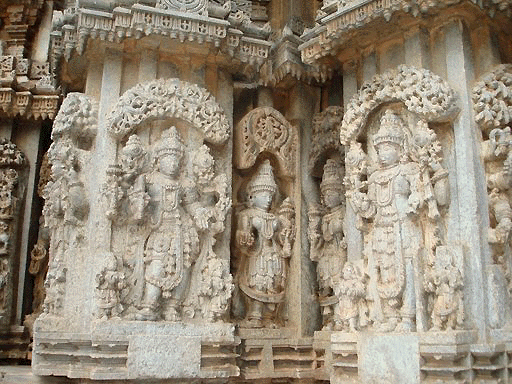
Kesava Temple sculptures The Kesava Temple is best known, however, for the excellent sculptured ornamentation on the outside walls. A railed parapet around the three central shrines is covered with bas relief images of elephants, horses, and scenes from the Vedic epics. There are many divine personalities included among the imagery, including Lord Brahma. Some of the more prominent images have the name of the artist carved into the pedestal. The Lord Brahma's image at Kesava Temple is one of the finest examples of its kind. It is situated on the exterior of temple, south Vimana, south side. Brahmadeva is shown with three heads, all bearded. Four-armed, his two lower hands hold mala and lota, while his upper hands hold two beautiful emblems. The arm holding lota appears to be resting on a staff. The paraphernalia in his upper right hand, which looks at first glance like a lotus bud on a long stem, is actually the head of a boar. In his upper left hand, he holds a very ornate emblem we assume is a stylized conch. Standing at Brahma's feet are his consorts, Gayatri and Savitri, in tribanga pose. Brahma is very ornately dressed and ornamented, and stands beneath a lintel of lotus buds.
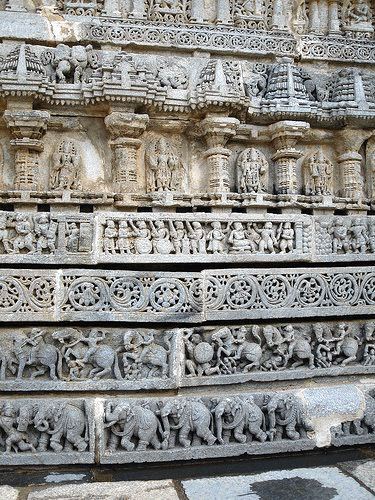
Kesava Temple at ornamentation The Garuda-stambha (flag pole) is not exactly opposite the temple entrance, as is usually the custom. Here, it sits off to the northeast. It is said that when this temple was completed, it was so beautiful and Lord Indra tried to carry it off to Indraloka. At Indra's urging, the building began to rise from the earth. Fortunately his effort was thwarted, and the building was put back down, although slightly out of position.
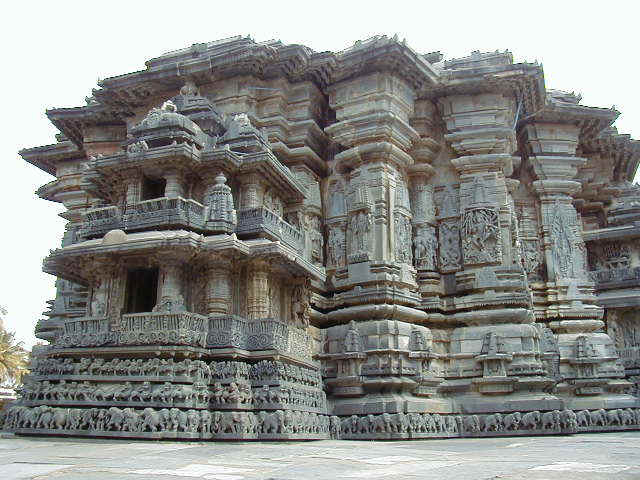
Halebid Temple
In the Hassan district of Karnataka is the temple village of Halebid, which is home to the ornately beautiful Hoysala shrines, Hoysaleswara and Kedareswara Temples. Also known as Dorasamudra or Dwarasamudra, Halebid (Halebidu) was the Hoysala capital during the reign of their 12th century empire. The temple complex has two Vaisnava temples, the Hoysaleshawara and Kedareshwara Temples, along with a Jain basadi. There is a large lake in front of the temple compound from which the village got its name, Dwara-samudhra, meaning 'entrance from the ocean'. there is also a high degree of degradation in temples built of such soft stone, and Halebid suffers that fate as well. Guarding the temple is a magnificent Nandi which was never completed, despite having been worked on for 86 years. A tremendous array of devotional imagery is found carved into the temple's interior and exterior, including several excellent images of Lord Brahma.
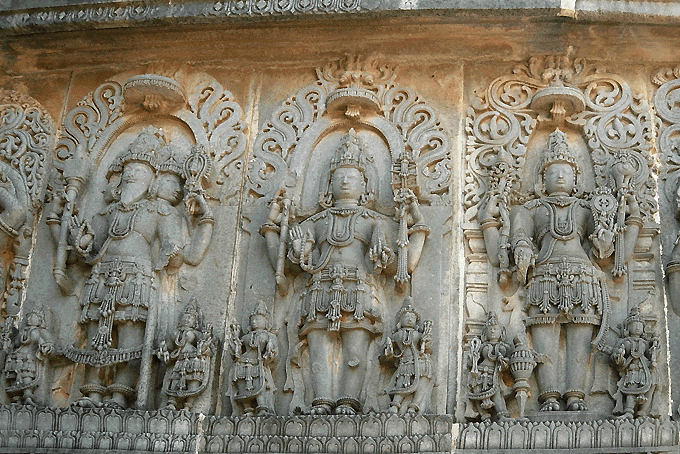
Lord Brahma in Trimurti at Halebid [ Click for larger version ] One of the best known images of Brahma at Halebid is the Trimurti panel, which depicts all three members, each with their consorts. Lord Brahma is shown with three heads, two bearded. Four-armed, he holds the mace and a stylized conch in his upper hands, and a mala in his lower right. The lower left hand is gone, but no doubt held a lota. Again, he is ornately dressed and ornamented. All three members stand on a lotus pedestal.

Lord Brahma at Halebid In the example above, Lord Brahma stands alone, four-armed with three heads, all of which are beardless. The age conveyed in this murti is of a young Brahma. Ornately dressed, he holds both conch and mace emblems, and again, the mace appears to have a small boar head. In his lower hands he holds the lota and mala, although part of the mala is missing. His consorts stand at his feet.
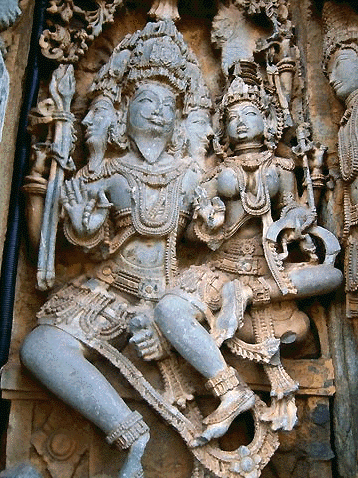
Lord Brahma and Saraswati at Halebid In the image above, we again see Brahmadeva with three bearded heads, this time with Saraswati seated beside him. Below, Lord Brahma sits astride his hamsa-vahana, who seems particularly muscular in this image. In the panel to the right is Ganesh on his vahana, mooshika. This group of Brahma images from Halebid shows the depth of personality, detailed paraphernalia, and uniqueness of mood in a wonderful range of sculptures.

Lord Brahma on Hamsa, Halebid
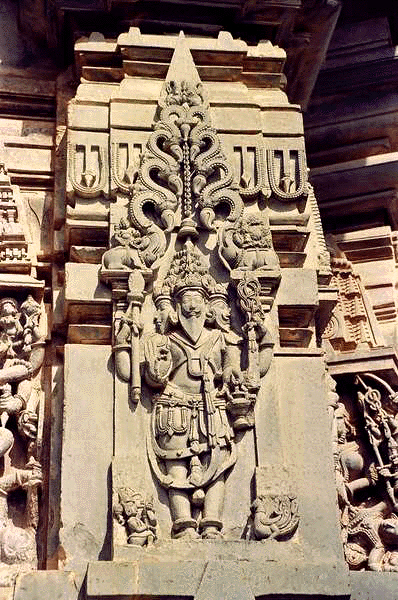
Lord Brahma at Belur 16 km. away from Halebid is the village of Belur, which is home to the Chennakeshava Temple. This Vaisnava temple is dedicated to Visnu, who is actively worshipped there to this day. Both the Hoysaleswara Temple at Halebid and the Chennakeshava Temple in Belur were commissioned by Hoysala king, Vishnuwardhana, in the 12th century. The king had converted from Jainism to Vaisnavism, and built this temple in honor of the Lord. Like Hoysaleshwara, the Chennakeshava Temple is a star-shaped floor plan, built on a platform. It was constructed from soapstone so again, we find highly ornate carving inside and out. The sculpture of Lord Brahma here is very beautiful, and quite unusual. He stands under a sharply pointed pyramidal lintel bearing two riders on elephants (one rider is missing). Holding the mace and a stylized chakra in his upper hands, a mala and lota in his lower hands, Brahma is dressed with slightly less ornate gear in this image. Interestingly, his three faces appear to depict three different ages. The center bearded face appears to be the senior profile, while the beardless face on the left looks quite young, and the right-facing, with a shorter beard, seems to be of middling age. At Brahmadeva's feet are his consort and hamsa vahana. Considering the excellence of these Karnataka sculptures of Lord Brahma, we can only imagine what it would be like to view an entire collection of every Brahma carved into an India temple. It would no doubt be akin to seeing Lord Krsna's virat-purusa – far too awesome to comprehend.
| |
